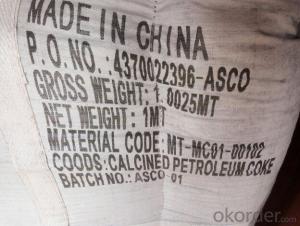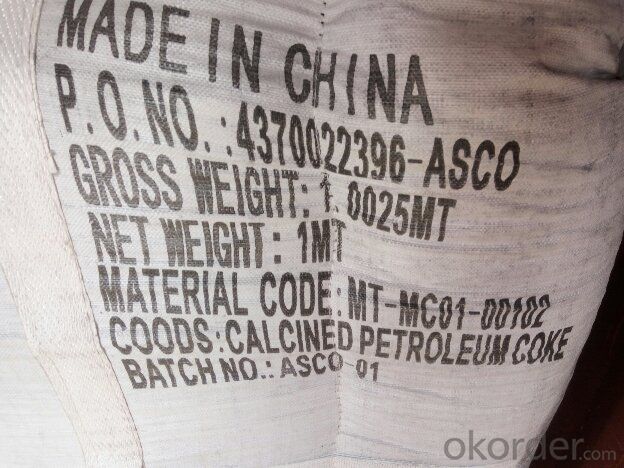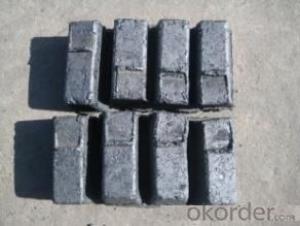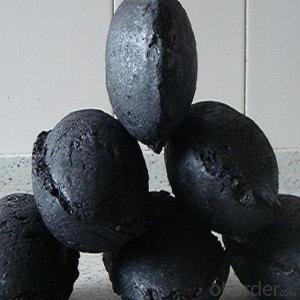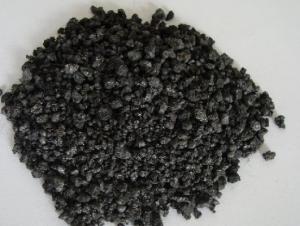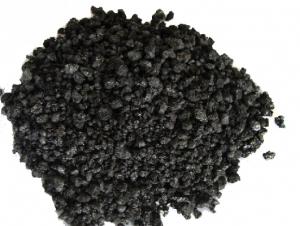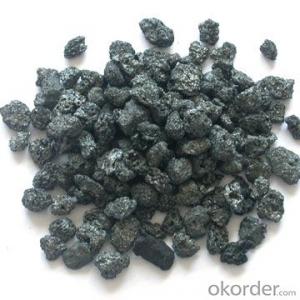Calcined Petroleum Coke with FC 98.5%min
- Loading Port:
- Shanghai
- Payment Terms:
- TT OR LC
- Min Order Qty:
- 19.7
- Supply Capability:
- 1007 m.t./month
OKorder Service Pledge
OKorder Financial Service
You Might Also Like
Intrduction
Carbon additive to ningxia production of anthracite as raw material, after washing, crushing, high temperature calcination, filter, etc. Craft refined and become.This is after the anthracite calcination generated high carbon content and low volatile component of the new product, is an ideal raw material to make steel.Steay supply
Calcined Petroleum Coke comes from delayed coke which extracted from oil refinery. Although Calcined Petroleum Coke contains a little bit higher level of sulfur and nitrogen than pitch coke, the price advantage still makes it widely used during steel-making and founding as a kind of carbon additive/carburant.
Features
In the smelting process for reducing agent. Performance: replace the traditional oil carbon additive, decrease the cost of steelmaking. Features: low ash. low sulfur,low phosphorus, high calorific value. High ratio resistance,high mechanical strength,high chemistry activity. It is mainly used for metallurgy reductant inoculants, casting, refractory materials, machinery, electronics and other fields.
1) high absorption rate, it can be absorbed up to 90%.
2) absorbed more quickly than other carbon additive; no residue remains in furnace.Good quality
3) low Sulfur, the lowest can reach below 0.20%; low nitrogen, normally below 200ppm (0.02%)
Specifications
CPC | |||
F.C.% | 98.5MIN | 98.5MIN | 98MIN |
ASH % | 0.8MAX | 0.8MAX | 1MAX |
V.M.% | 0.7 MAX | 0.7 MAX | 1 MAX |
SULFUR % | 0. 5MAX | 0. 7MAX | 1MAX |
MOISTURE % | 0.5MAX | 0.5MAX | 1MAX |
Pictures
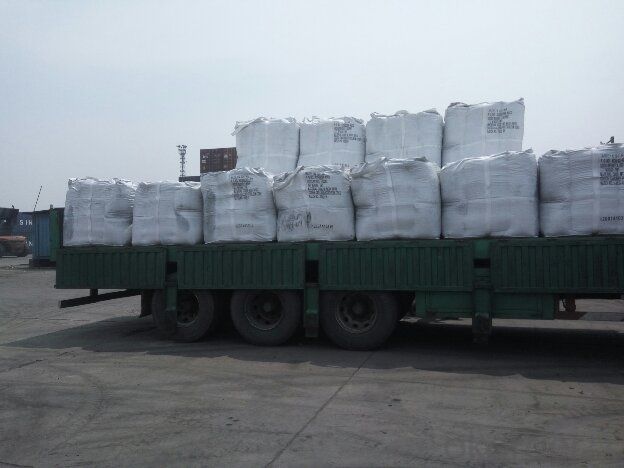
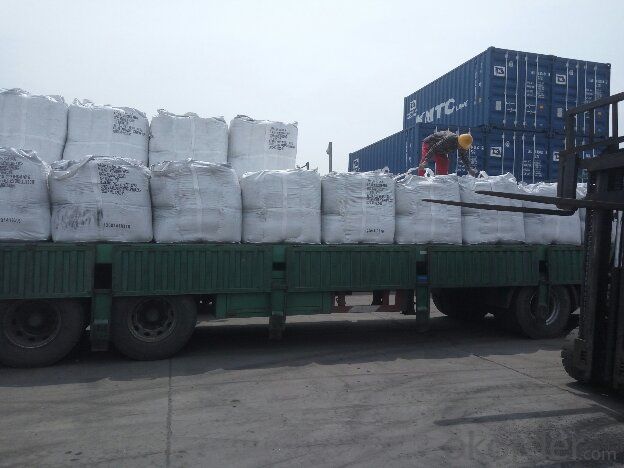
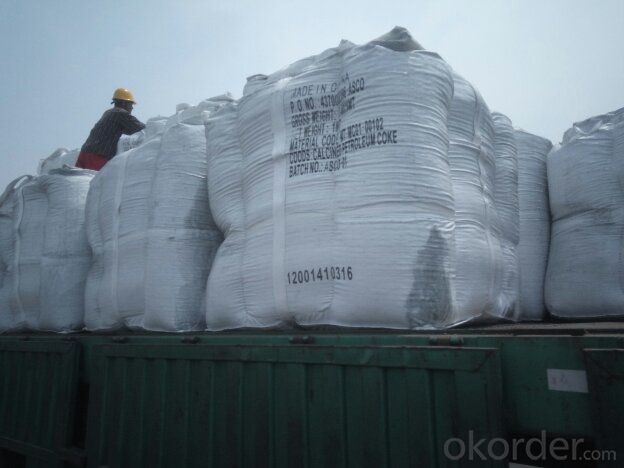
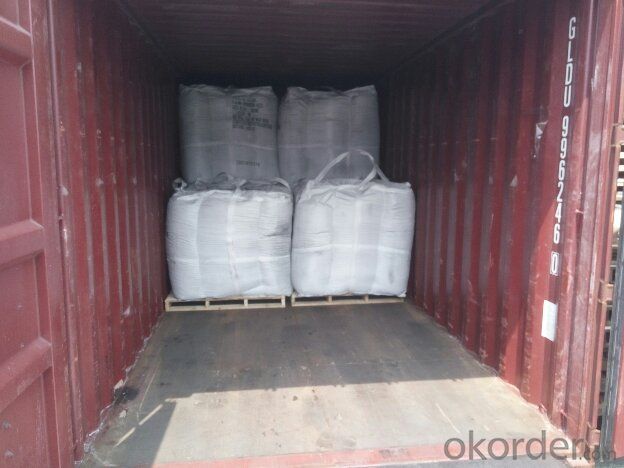
FAQ:
(1)CPC could be as fuel
Petroleum coke is a material relatively low in cost and high in heat value and carbon content with good chemical stability, making it an efficient and costeffective fuel for producing metal, brick and related products.
(2)CPC could be as Graphite Electrodes
Graphite can be produced from lowsulfur needle petroleum coke, which must be heated above 5,432 degrees Fahrenheit.
(3)CPC could be as Anodes
Calcined petroleum coke, often low in sulfur and metallic impurities, is used to make anodes for
the smelting industry.Calcined petroleum coke is mixed with coal tar pitch in the production of
anodes.
- Q: How does carbon affect the formation of droughts?
- The formation of droughts is significantly influenced by carbon dioxide (CO2) and other greenhouse gases. Human activities, such as the burning of fossil fuels and deforestation, have caused an increase in carbon emissions, leading to higher concentrations of CO2 in the atmosphere. This rise in CO2 acts like a blanket, trapping heat and causing the Earth's average temperature to rise, a phenomenon known as global warming. As global warming occurs, the hydrological cycle, which regulates the availability of water on Earth through evaporation, condensation, and precipitation, becomes more intense. Warmer temperatures increase the rate of evaporation, resulting in more moisture being stored in the air. This increased moisture content can lead to heavier rainfall and more severe storms in certain areas. However, despite the increase in extreme rainfall events, global warming also causes a decrease in overall precipitation in many regions. Higher temperatures cause more evaporation from soil, lakes, and rivers, depleting available water sources. Consequently, droughts become more frequent and severe. Moreover, the warming climate alters atmospheric circulation patterns, such as the jet stream, which affects weather systems. These changes can cause shifts in precipitation patterns, resulting in more regions experiencing prolonged dry periods and exacerbating the risk of drought. Additionally, the impacts of carbon emissions and global warming go beyond their direct effects on precipitation. Rising temperatures accelerate the rate of evapotranspiration, the process through which water is transferred from the land to the atmosphere via evaporation from the soil and transpiration from plants. This increased evapotranspiration leads to higher water demand from vegetation and crops, further contributing to water scarcity and drought conditions. In conclusion, carbon emissions and global warming have a significant impact on the formation of droughts. The increase in CO2 concentrations traps heat, leading to increased evaporation rates, changes in atmospheric circulation, and shifts in precipitation patterns. These factors, combined with higher evapotranspiration rates, result in more frequent and severe droughts. To reduce the risk and impact of droughts in the future, it is crucial to address carbon emissions and take measures to mitigate climate change.
- Q: How does carbon impact the stability of desert ecosystems?
- Desert ecosystems can be influenced both positively and negatively by carbon. On the positive side, carbon is crucial for all living organisms and is a vital component of organic matter. It plays a critical role in essential processes like photosynthesis, respiration, and decomposition that are necessary for the survival and growth of plants and other organisms in deserts. During photosynthesis, plants take in carbon dioxide, a type of carbon, to produce glucose and oxygen, which are essential for their growth. This supports the stability of desert ecosystems by promoting primary productivity and the food web. However, the excessive release of carbon into the atmosphere, primarily caused by human activities such as burning fossil fuels and deforestation, has resulted in an increase in greenhouse gases, including carbon dioxide. This leads to global warming and climate change, which have detrimental effects on desert ecosystems. The rising temperatures can disrupt the delicate balance of desert ecosystems, impacting the distribution and abundance of plant and animal species. Some plants may struggle to adapt to the changing climate while others may benefit, resulting in changes to species composition and the potential loss of biodiversity. Additionally, elevated levels of carbon dioxide can impact water availability in desert ecosystems. Higher carbon dioxide levels can enhance water-use efficiency in plants, allowing them to conserve water. While this can be advantageous in water-limited environments such as deserts, it can also alter water dynamics, affecting the availability of water resources for other organisms in the ecosystem. To summarize, carbon is essential for the stability of desert ecosystems as it supports primary productivity and the functioning of food webs. However, the excessive release of carbon into the atmosphere contributes to climate change, negatively impacting desert ecosystems by altering species distribution, reducing biodiversity, and affecting water availability. It is crucial to mitigate carbon emissions and promote sustainable practices to ensure the long-term stability and resilience of desert ecosystems.
- Q: What are the impacts of carbon emissions on glacier retreat?
- Glacier retreat is significantly affected by carbon emissions. Human activities, such as burning fossil fuels and deforestation, release carbon dioxide and other greenhouse gases into the atmosphere, contributing to global warming. This rise in global temperatures directly affects glaciers. Glaciers are massive ice bodies that form over long periods from accumulated snowfall. They serve as natural freshwater reservoirs, providing an essential source of drinking water to millions of people worldwide. However, as carbon emissions cause the Earth's temperature to increase, glaciers melt at a faster rate. The warming climate causes glaciers to lose more ice through melting than they gain through snowfall. This results in a net ice loss, leading to glacier retreat. As glaciers retreat, they not only decrease in size but also become thinner. This reduces their water storage capacity, impacting water availability in regions that rely on glacial meltwater for drinking, irrigation, and hydropower. Moreover, glacier retreat has extensive implications for ecosystems and biodiversity. Glaciers offer unique habitats for various species, including plants, animals, and microorganisms that have adapted to survive in extreme environments. As glaciers vanish, these species must adapt or relocate to other areas, disrupting ecosystem equilibrium. The consequences of glacier retreat extend beyond local and regional scales. Glacial meltwater contributes to rivers and lakes, ensuring a consistent water flow throughout the year. As glaciers shrink, this flow diminishes, leading to water scarcity during dry periods. This poses a threat to agriculture, urban water supplies, and the overall sustainability of ecosystems reliant on stable water sources. Additionally, glacier loss contributes to rising sea levels. When glaciers melt, the water they release flows into the oceans, causing them to expand. This worsens coastal erosion, increases the risk of flooding in low-lying areas, and endangers coastal communities and infrastructure. In conclusion, carbon emissions profoundly impact glacier retreat. The resulting global warming accelerates glacier melting, leading to water scarcity, loss of biodiversity, rising sea levels, and various environmental and socio-economic consequences. It is crucial to address carbon emissions and take action to mitigate climate change in order to preserve these crucial ice formations and the ecosystems and communities that depend on them.
- Q: What is the carbon content of 45# steel?
- Between 0.42- and zero point five zero percent per cent
- Q: What are the effects of carbon emissions on the Arctic ecosystem?
- Carbon emissions have significant effects on the Arctic ecosystem, primarily due to the phenomenon of global warming. As carbon dioxide and other greenhouse gases are released into the atmosphere, they trap heat, leading to increased temperatures worldwide. However, the Arctic is particularly vulnerable to these effects due to its unique characteristics. One of the most significant impacts of carbon emissions on the Arctic ecosystem is the rapid melting of ice. Rising temperatures cause glaciers and ice sheets to shrink, leading to the loss of habitat for ice-dependent species such as polar bears, walruses, and seals. These animals not only rely on the ice for resting and breeding but also for hunting and finding food. With the reduction of their natural habitat, their populations are declining, impacting the delicate balance of the Arctic food chain. Additionally, the melting of ice results in rising sea levels, which can have cascading effects on coastal areas. Many Arctic communities, including indigenous peoples, are located near the coast and depend on the sea for their livelihoods. Increased erosion, flooding, and storm surges due to rising sea levels threaten their homes, infrastructure, and traditional ways of life. Furthermore, carbon emissions contribute to ocean acidification, a process in which the absorption of excess carbon dioxide by seawater leads to a decrease in its pH level. This acidification has detrimental effects on marine organisms such as shellfish, corals, and plankton, which struggle to build and maintain their calcium carbonate structures. These organisms are essential food sources for various Arctic species, including fish, seabirds, and marine mammals. The decline in their populations disrupts the intricate web of life in the Arctic and can have far-reaching consequences. Climate change caused by carbon emissions also disrupts the timing and patterns of seasonal events, such as the timing of plant growth, the migration of birds, and the availability of food resources. This mismatch can have severe consequences for species that rely on specific timing for reproduction, migration, and survival. Overall, the effects of carbon emissions on the Arctic ecosystem are profound and wide-ranging. The loss of sea ice, rising sea levels, ocean acidification, and disrupted ecological processes all contribute to the vulnerability of Arctic species and communities. Urgent action to reduce carbon emissions, mitigate climate change, and protect this fragile ecosystem is crucial for the long-term preservation of the Arctic.
- Q: How does carbon affect the formation of wildfires?
- Wildfires are not directly impacted by carbon, but their intensity and duration are heavily influenced by it. Carbon is a vital component of organic matter, including vegetation and deceased plants, which act as fuel for wildfires. When a wildfire occurs, the heat causes the carbon in these fuels to react with oxygen, resulting in combustion. This process releases energy in the form of heat, light, and gases, such as carbon dioxide (CO2) and carbon monoxide (CO). The presence of carbon-rich fuels significantly contributes to the spread and intensity of wildfires. Dry and dead vegetation, often referred to as fuel loads, are extremely flammable and enable fires to rapidly expand. Furthermore, the amount of carbon present in these fuels determines the amount of energy released during combustion. As a result, the higher the carbon content, the more intense the fire becomes. Additionally, the combustion of carbon during wildfires releases substantial amounts of carbon dioxide into the atmosphere. Carbon dioxide is a greenhouse gas that traps heat in the Earth's atmosphere, contributing to the greenhouse effect and ultimately leading to global warming. Elevated levels of carbon dioxide in the atmosphere worsen climate change, further impacting the frequency and severity of wildfires. In conclusion, carbon indirectly influences the formation of wildfires by acting as fuel for combustion. The carbon content in vegetation and deceased plants determines the intensity and spread of wildfires, while the release of carbon dioxide during combustion contributes to the long-term effects of wildfires on climate change.
- Q: What are the consequences of increased carbon emissions on global food security?
- Global food security is significantly impacted by increased carbon emissions, with a range of consequences. One immediate effect is the alteration of weather patterns and an increase in extreme weather events, such as droughts, floods, and heatwaves. These events can result in crop failures, reduced agricultural productivity, and the loss of livestock, ultimately leading to food shortages and price instability. In addition, carbon emissions contribute to climate change, which causes long-term shifts in temperature and precipitation patterns. Higher temperatures can accelerate the growth and reproduction rates of pests and diseases, posing a severe threat to crops and livestock. Furthermore, changes in rainfall patterns can disrupt the timing and quantity of water available for irrigation, further reducing agricultural productivity. Moreover, carbon emissions contribute to ocean acidification, negatively impacting marine ecosystems and the livelihoods of fishing and aquaculture communities. This can result in a decline in fish stocks, jeopardizing an essential source of protein and nutrition for millions of people. Increased carbon emissions also lead to the loss of biodiversity. Climate change disrupts ecosystems, leading to the extinction or migration of plant and animal species. This loss of biodiversity reduces the resilience and adaptability of agricultural systems, making them more susceptible to pests, diseases, and environmental pressures. Ultimately, the consequences of increased carbon emissions on global food security are extensive and intricate. They include diminished agricultural productivity, rising food prices, food shortages, and limited access to nutritious food. Addressing carbon emissions and mitigating climate change is vital to ensure a sustainable and secure global food system for future generations.
- Q: How to extinguish the charcoal fire?
- 1, occasionally a barbecue, natural can be extinguished, the embers can be used for heating the future and food to eat and to cool the.2. Place a bucket of water in the oven. The correct way is to remove the carbon and put it out. Don't add water to the stove.3, the most economical way to extinguish the remaining fire with water poured into the half iron, after drying can be reused.4, the most important tip, barbecue is completed, the remaining ash without Mars, water must be extinguished once again to prevent a stirring among the dry bones.
- Q: How does carbon impact the availability of sustainable development policies?
- Carbon impacts the availability of sustainable development policies by directly contributing to climate change. The excessive emission of carbon dioxide and other greenhouse gases from human activities leads to global warming, which in turn affects natural resources, ecosystems, and communities. To mitigate the negative impacts of carbon, sustainable development policies aim to reduce carbon emissions, promote renewable energy sources, and encourage sustainable practices. By addressing carbon emissions, these policies help create a more sustainable future by preserving resources, minimizing environmental degradation, and fostering social and economic well-being.
- Q: I want to make a rectangular round bar for bearing. What carbon fiber and carbon fiber should be used? How should I do it? What kind of machine does it use to dry it?
- Pultrusion process: it is a kind of molding process with fast development speed, that is, the fiber is impregnated with resin through the resin trough, and then enters the heating die to solidify, and makes all kinds of profiles of different shapes. The utility model has the advantages that the parts with complex shape and accurate size can be pressed at one time, the productivity is high, but the process equipment is complex, and the product is not suitable for producing small batch and big size products.Resin transfer molding (RTM) is a kind of molding process in 90s the most popular, which will enhance the material preform into a closed mold, in vacuum and pressure conditions, the resin is injected into a mold and curing.Weaving process: the process of three-dimensional braiding is the process of weaving all fibers in the same direction, and then each fiber bundle is moved along its own direction, one angle interlaced with each other, forming the fabric.
Send your message to us
Calcined Petroleum Coke with FC 98.5%min
- Loading Port:
- Shanghai
- Payment Terms:
- TT OR LC
- Min Order Qty:
- 19.7
- Supply Capability:
- 1007 m.t./month
OKorder Service Pledge
OKorder Financial Service
Similar products
Hot products
Hot Searches
Related keywords
